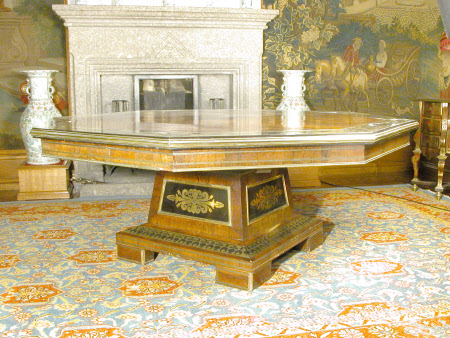Centre table
attributed to George Bullock (c.1783 - London 1818)
Category
Furniture
Date
circa 1810
Materials
Rosewood, brass, ebony, mahogany drawer linings
Measurements
73 cm (Height); 181 cm (Diameter)
Place of origin
London
Order this imageCollection
Lanhydrock, Cornwall
NT 882659
Summary
A large rosewood, ebony and brass inlaid octagon table, English, circa 1810. Attributed to George Bullock. The top with a broad outer brass border inset with ebony 'thyrsus' motifs to each of the eight sides and a floral rosette at each point, the shallow frieze containing a drawer, on a large tapering stepped square pedestal base, each face with a panel and thyrsus-like motif in brass on ebony background, the step with repeating motif of a crescent alternating with a flower head, standing on block feet.
Full description
The distinctive ornament seen on this octagon table is similar to that seen on furniture known to have been made by George Bullock. These and other designs by him are preserved in a series of tracings and engravings in a scrapbook known as the 'Wilkinson Tracings', as the first page is entitled 'Tracings by Thomas Wilkinson, from the designs of the late Mr George Bullock 1820'. It was acquired in 1974 by Birmingham Museum and Art Gallery. A closely similar octagon table is illustrated in Blairman/Murray 'George Bullock Cabinet-Maker', 1988, Fig.1. George Bullock (d.1818). Not much is known about his early background until he is listed as a Modeller and Sculptor in the Liverpool Trade Directories in 1804. By 1809/10 he was in partnership with Joseph Gandy and their firm was listed as Architects, Modellers, Sculptors, Marble Masons, Cabinet Makers and Upholsterers. By 1813 George Bullock appears in the London Directories as Upholsterer based in Piccadilly then Hanover Square and by 1815 has a second address listed as Mona Marble and Furniture Works, Oxford Street. He was perhaps the leading practitioner of the Boulle revival in Regency England. His foliate marquetry drew from both classical motifs and British flora. In each case he tended to inlay in stylised forms, often, as here, intertwining foliage around a central straight pole. This motif derives from the ancient Greek 'thyrsus' which was a giant staff wrapped with ivy used in festivals. He was also well known for his sophisticated use of native marble and timber, particularly oak, often in combination with exotic veneers.
Provenance
Acquired during transfer of the house to the National Trust in 1953. Photographs taken in the 1940's show this table in the Long Gallery at Lanhydrock.
Makers and roles
attributed to George Bullock (c.1783 - London 1818), cabinetmaker attributed to George Bullock (c.1783 - London 1818), furniture designer
References
Wainwright, Clive 'George Bullock: Cabinet Maker' London 1988, Fig 1
